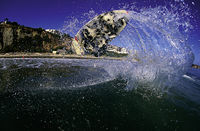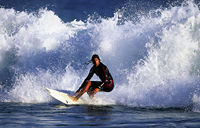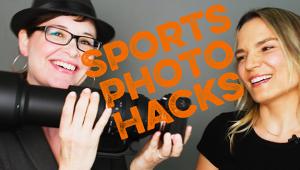Shooting Dramatic Surfing Photos
|
Tips from a photography director.
Have you ever wanted to shoot sports, particularly surfing images? Photographing high action isn't as easy as it looks, according to Larry "Flame" Moore, director of photography at Surfing magazine, a publication that keeps its pulse on the latest events in the surfing world. He says that ideally, the best photos are captured at the peak of action, in great lighting conditions, and are razor-sharp. "People who are serious about surfing photography must invest in top-notch photo equipment," he emphasizes. Surfing's staff and contributing photographers use the best in autofocusing cameras, he says. Recommended Tools Flame says that next to the 600mm lens, he likes using the EF 300mm f/2.8. He also uses the EF 70–200mm f/2.8 Image Stabilizing (IS) lens as "a good 'contest' lens—it's great for photographing someone winning an award, as well as for shooting sports from a rocking boat." When shooting from water, he says, Flame believes in using everything from a 15mm fisheye up to a 135mm—"all fixed focal length." When shooting with the 15mm lens, he uses a Canon EOS 630 in a custom-built underwater housing, "to make my equipment as small and lightweight as possible." When shooting with longer lenses from the water, he uses the Canon EOS 1v. Without exception, he says, he sets his exposures manually. And he re-emphasizes the importance of a top-notch autofocusing system. "With the AF technology today, you should be able to get 36 out of 36 exposures right on, unless you're not paying attention." As for film, Flame recommends Fujichrome Velvia ISO 50, which he feels is better at a higher EI. "Most of us push Velvia to EI 64, and a few even push it to 80," he explains. "When pushing Velvia to EI 64 in good light, your exposures should be near 1/500 at f/5.6." He also likes Kodak Ektachrome E100VS (rated at 100), but feels that this film is "more suitable for tougher lighting conditions, like a cloud cover or in harsh midday sun." He says that Surfing magazine requires original transparencies for reproduction, and although most images used in the magazine are in color, they also print some black-and-white work. Flame sometimes shoots with Agfa Scala, a black-and-white transparency film. For photographers who submit black-and-white prints to the magazine, Flame asks that they include their negatives with a proof sheet. And of course, the magazine also accepts high-resolution digital images. "Our requirements are that digital images be 266 dpi at 16.5x103/4 inches, a two-page spread size." Filling the Frame "One of the goals of all sports shooters should be to fill the frame with the action," he points out, adding that photographers should find a vantage point from which they can do this. When shooting, Flame says he anticipates action and captures it by "getting the shot before the moment of peak action and the shot right afterward." For those just starting out in sports photography, he recommends taking careful notes on what you're doing. "We have a photographic system we feel works best. It involves standardization, which means developing a working routine and sticking with it." He says he believes that by consistently using particular films and photo equipment, "you can identify and eliminate problems of color, grain, exposure and sharpness, allowing you to concentrate on technique." About 75% of all published surfing photos are shot from the beach, says Flame. In Hawaii, however, photographers shoot about half their images from the shore. He notes, "Shooting from the water requires a specialized photographic skill all its own." Rather than photograph random surfers on the beach, Flame coordinates his photo sessions, and "liaisons with the better surfers in the area." Surfing magazine contacts some of the surfers they feature, while others contact the publication directly. Traveling the Globe Flame's career began once he started submitting photos to Surfing. Later, he says, "I found myself traveling the globe" as a staff photographer. "Oftentimes, you may find you have opportunities to shoot surf in other areas. Many photographers spend time in Hawaii during the winter because that's an optimum season for that location. Many Surfing magazine photographers are never home!" Flame says it's a feather in his cap to see their photographers move on to be high-action photographers for other magazines. Flame loves surfing as a sport, in addition to photographing it. He's enjoyed a successful career that's spanned 30+ years, with 43 Surfing cover shots to his credit. In 2001, he was one of the founding members of swell.com, a direct-marketing company for the surf and skateboard markets. In January, 2003, he "hit a little bend in the road, to put it mildly," when he had a nine-centimeter tumor removed from his skull (he's been cancer-free for nearly a year.) Also in 2003, Flame was inducted to the Surfing Hall of Fame for his cultural contributions to the sport. |






















































